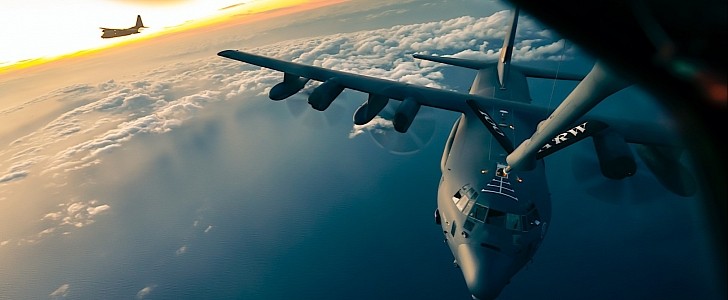The U.S. Air Force (USAF) has made a habit of releasing with regularity images of its machines in action. It does so, probably, for two reasons. First, spectacular images have a great chance of attracting fresh talent into the military. Secondly, military hardware in action is the best way to tell the enemy what America can unleash, if provoked.
Most of the pics the USAF releases are spectacular on account of the machines shown, and at times, on account of how they blend in with their surroundings. But not the one we have here, released by the same Air Force – one that despite the fact it shows three incredible airplanes doing their thing, has another spectacular element about it.
The three-plane formation comprises two MC-130J Commando IIs in need of fuel and a KC-135 Stratotanker ready to supply it in a mission over the North Sea in late July. The image was snapped from inside the Stratotanker as one of the Commandos was attached to its refueling boom.
Behind the planes though, a world of wonders unfolds, with the vastness of the sea far below, groups of clouds shadowing it here and there and, most importantly, the curvature of our planet apparently visible in the distance, where the dark clouds met the orange-hot sky, lit up by the rising or setting Sun.
Given how many people take to the sky each day, you’d think more of them get to experience this vista and capture it on film, but they don’t, and that’s what makes this pic so spectacular.
It’s generally agreed that the Earth, being a sphere and all, curves by eight inches per mile (20 cm per 1.6 km). That gives anyone looking into the horizon from ground level a visual range of just 3 miles or so (4.8 km), because the planet itself obstructs your view.
Things change, of course, the higher one goes. Sadly, we’re not told how high these USAF pilots were flying when the pic was taken, but the Earth's curvature becomes clearly visible at 35,000 feet (over 10,000 meters), provided other conditions, like field of view width, are met.
The three-plane formation comprises two MC-130J Commando IIs in need of fuel and a KC-135 Stratotanker ready to supply it in a mission over the North Sea in late July. The image was snapped from inside the Stratotanker as one of the Commandos was attached to its refueling boom.
Behind the planes though, a world of wonders unfolds, with the vastness of the sea far below, groups of clouds shadowing it here and there and, most importantly, the curvature of our planet apparently visible in the distance, where the dark clouds met the orange-hot sky, lit up by the rising or setting Sun.
Given how many people take to the sky each day, you’d think more of them get to experience this vista and capture it on film, but they don’t, and that’s what makes this pic so spectacular.
It’s generally agreed that the Earth, being a sphere and all, curves by eight inches per mile (20 cm per 1.6 km). That gives anyone looking into the horizon from ground level a visual range of just 3 miles or so (4.8 km), because the planet itself obstructs your view.
Things change, of course, the higher one goes. Sadly, we’re not told how high these USAF pilots were flying when the pic was taken, but the Earth's curvature becomes clearly visible at 35,000 feet (over 10,000 meters), provided other conditions, like field of view width, are met.








